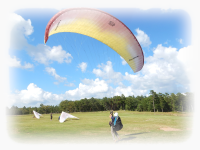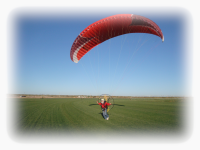Mexican border operations by ultralights
by Had Robinson
Notify the U.S. Air Marine Operations Center
There are rules when flying near the Mexican border. You may also experience an emergency and be forced to land in Mexico. What to do? Will you get in trouble? What about entering Mexican airspace?
The United States has specific rules for entering and exiting its domestic airspace, such as flying into and out of Mexico. The boundaries of the U.S. airspace is known as an ADIZ (Air Defense Identification Zone). Here are the official rules from the FAA:
All aircraft entering U.S. domestic airspace from points outside must provide for identification prior to entry or exit. ADIZs have been established to assist in early identification of aircraft in the vicinity of international U.S. airspace boundaries (AIM Section 6, 5-6-1).
Many aircraft inbound to the U.S. will cross an ADIZ. There is no ADIZ between the U.S. and Canada. According to FAR Part 99, if penetrating an ADIZ, all aircraft of U.S. or foreign registry must file, activate, and close a flight plan with the appropriate aeronautical facility. In addition to normal ADIZ position reports, and any other reports Air Traffic Control may require, a foreign civil aircraft must give a position report at least one hour before ADIZ penetration, if it is not more than two hours average cruising speed from the U.S.
For Defense VFR (DVFR) flights, the estimated time of ADIZ penetration must be filed with the appropriate aeronautical facility at least 15 minutes before penetration, except for flights in the Alaskan ADIZ, in which case, report prior to penetration. Additionally, VFR pilots must receive and transmit a discrete transponder code.
Be sure to activate your flight plan before crossing the ADIZ.
Because it is not practical to carry a transponder aboard our tiny aircraft (though I have done it for the DoD), the Federal authorities have allowed those who fly ultralights like hang gliders and paragliders to satisfy the requirements for operating in an ADIZ in other ways. Here is what to do:
- Call the Air Marine Operations Center (AMOC) in Riverside, CA: (800) 553-9072 These are the people who monitor the ADIZ of the U.S.
- Ask the operator for the New Mexico sector (the group that monitors the border in our area).
- Give the operator the following information: a.) Who you are. b.) What you are flying e.g. a powered paraglider ultralight. c.) Where you plan to operate your aircraft e.g. a (10) mile radius of Dona Ana County Airport (DNA). d.) Hours of operation e.g. 1600-1800 hours Mountain standard time. e.) Whether you will be operating south of NM Highway 9. f.) The operator may ask for identifying characteristics of your aircraft e.g. primarily white/red in color. g.) The operator may also ask you for a contact number.
That is all you have to do. AMOC will notify the ground and air divisions of the US Border Patrol where you are flying so there are no surprises.
Below is a section of the ADIZ west of El Paso, Texas. The red arrows point to the zone (the magenta dots bordered on the outside by a magenta line). The ADIZ location is also the outside lateral edge of US class E airspace (the thick blue line).

Remember that you never want to be mistaken for the bad guys which is always a good reason to follow the rules. If they have to chase you in a helicopter, force you down, and have the riot squad waiting for you on the ground, you will be put to a lot of inconvenience. You have wasted their time, made people guarding our borders from cutthroats angry, and, depending on how much the helicopter pilot knows about paragliders, exposed yourself to significant risk from massive prop wash.
I hope you agree that the BP Agents have enough to do without having to deal with careless citizens who do not respect the rules that help protect our country from dangerous enemies. So, please make the call. It is so easy and it will also make it easier on the rest of us. Because I run a school, I already get calls from the BP and AMOC asking about some PPGer near the border. "Do you know him?" "Is he one of your students?" When I get these calls after dark, I am pretty sure it is nobody I know and I tell them so. What happened next? I don't really want to know.
What if you must land in Mexico?
It is not illegal for you to land in Mexico after coming from U.S. airspace. Getting back home can be complicated. Fortunately, there is NO traffic of any kind on the Mexican side during daylight (this is obvious by observation from the air for many years). Things change, however, at night. If you have to land after dark, stay away from the border a few hundred yards, find an arroyo or a big mesquite to hide in, curl up in your paraglider, and enjoy the beauty of the desert sky until dawn. DO NOT BUILD A FIRE. I.e. disappear. There is no law or protection south of the border. You are on your own.
- The new border fence cannot be easily scaled, especially if you have any gear. Proceed to the border. There are gates in the fence every mile which can be opened by the Border Patrol. I put the location of these gates on my GPS that covers the areas I generally fly near. Note: I am unsure whether they would be opened for a US pilot who had an emergency landing in Mexico but it does not hurt to ask. The new border fence extends about 20 miles west of the Santa Teresa port of entry where it becomes the old, easily crossable fence (for pedestrians).
- You or a contact should notify the Border Patrol and give them the mile marker number on the fence where you are and explain that you had an emergency landing in Mexico and need to re-enter the US. An agent will come to that location. He will likely tell you to proceed (on the Mexican side) to the nearest port of entry, Santa Teresa. In any case, the rules state that if an agent encounters a person attempting to cross into the US between ports of entry, the agent will not permit you to enter the US and tell you to go to the nearest port of entry.
- If, somehow, you cross the border with your gear (but not through one of the gates and past the 20 mile new fence), did not contact the BP, and are discovered by an agent, you will be detained and get a free ride to the port of entry (at least that’s what is supposed to happen). A customs official (CBP Officer) at the station will make the inspection and you may be allowed to proceed into the US. If you are not discovered or there is no agent there to meet you, you should proceed at once to a port of entry for an inspection. It is likely that you are being tracked so it is a good idea to follow the rules and go to the port of entry. Remember that you never want to be mistaken for the bad guys. The rules can be your best friend and my advice is to always follow them.
- If you have to proceed to the port of entry on the Mexican side, it may be a long walk. You then can enter the U.S. like everyone else. I have no idea what the Mexican officials will do when seeing a PPG pilot and all of his gear standing in line to cross the border. I would disassemble my gear somewhere far away from the port of entry as much as possible, dump all fuel, and look as innocent as possible. On the other hand, it would be FAR better for you to persuade some other pilot or relative to cross the border and pick you up at your location. It is easy to cross with a vehicle into Mexico as long you do not proceed more than 20 km from the border. Because there are no roads on the south side of the border fence, a good (4) wheel drive vehicle is required. It must be able to travel in soft, deep sand easily. The rescue vehicle must go completely around the Dell plant that is just west of the port of entry, travel through soft sand to the border, and head west as far as needed. You can pack your gear in the vehicle and head home. BE CERTAIN TO TELL THE US AGENTS AT THE PORT OF ENTRY EXACTLY WHAT HAPPENED. If you are one of my students (past or present), tell them.
- If you had to land in Mexico because of weather or some other reason AND your gear is still launchable, you can wait out the weather or whatever it is, launch, and proceed home. However, you must immediately go to the nearest port of entry for an inspection.
I had an emergency landing in Mexico due to weather about a year ago and it was easy for me to walk a mile and cross the border with my gear. A student who was with me earlier (but on the US side) called the BP, gave them my location, an agent met me, did an inspection, and re-admitted me into the US. Not only that, there was some fracas with the drug cartels nearby (it was dark by now) and the BP kindly escorted me out of the area. Hats off to the USBP. However, you may have a different experience than I did. Not everyone is a warm, lovable, and harmless little fuzz-ball....
The presence of the new fence greatly complicates things so be careful operating near the border. If you like to fly in Mexican airspace, it could be wise to fly high enough so that you always have an easy glide back home. Engines have this weird propensity to quit at the most inconvenient times. If I ran out of gas, I would persuade someone to bring fuel and a hose to my location so I could refill my tank through the fence and fly home. Just about anything is better than being stranded south of the border. For a $100 + costs, good friends might be persuaded to come pick you up. Whatever you do, don't make the news.
For the curious, here are the sections of the law (19CFR 123.1) that deal with a proper inspection and the penalties (19USC1459) if you want it your way.
![]()




